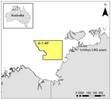The latest addition to Tideway’s fallpipe vessel fleet was named Flintstone during a high-tech ceremony in Zeebrugge, Belgium, in July – but the vessel itself was 11,000km away in Singapore being readied for an inaugural assignment in Chinese waters. Guests still got a good view of the newbuild however, thanks to 3D glasses and the latest animation technology. David Morgan reports.
Flintstone’s arrival could scarcely have been more opportune both for its owner and its first customer. For Nexans, ready to switch to rock protection after several unsuccessful attempts to trench three power cables installed between the Chinese mainland and Hainan Island for Guangdong NanDian Power, it meant help was just four days’ sailing away. And for Tideway, as well as the competitive advantage this proximity clearly provided when tendering, it also meant a first assignment in the rapidly growing Chinese offshore market.

Flintstone left Singapore on 25 July following completion of sea trials that were, in the words of Tideway director Hugo Bouvy, ‘almost perfect’. The DP2 vessel demonstrated ‘excellent manoeuvrability’, he adds, and its recordsetting fallpipe system worked ‘really well’.

Bouvy says the new multipurpose vessel embodies his company’s hardwon learnings from 20 years in the demanding subsea intervention business. Unlike sister DP fallpipe vessels Rollingstone and Seahorse, which resulted from existing vessel conversions, Flintstone was built entirely from scratch, giving the Tideway development team the freedom to innovate in her design and outfitting. State-of-the-art technology is much in evidence, particularly around the innovative, Huisman-supplied fallpipe system (OE August 2010).

The Flintstone fallpipe is rated for rock placement operations in 2000m of water, more than double the current fallpipe water depth record – 983m – established by Rollingstone in the Mediterranean a few years back. The special high grade aluminium employed in the fallpipe’s construction has never been seen before outside the materials development programme for the European Joint Strike Fighter aircraft. And the fallpipe handling system, like all the other onboard processes, is fully automated to optimise operational efficiency and minimise the crew’s exposure to risks.
Substantially bigger than her sister vessels, Flintstone was built under the Lloyd’s Register environmental protection code and boasts ice-class notation, a 19-20,000t load carrying capacity, a transit speed of around 15 knots and a draft when fully loaded of just 7.85m.
The ice-class will come into play on its second assignment following completion of the Nexans job. The vessel is currently scheduled to join other members of the Tideway fleet working in the Finnish Gulf on pipeline protection work for the second of the challenging twin Nord Stream gas trunk lines running from Russia to Germany via the Baltic. Flintstone is likely to see a lot more action in this frontier region as Nord Stream is one of three projects in Russian waters for which Tideway is simultaneously providing rock placement services, the others being the pipeline crossing in the Kara Sea’s Baydaratskaya Bay and scour protection around the Prirazlomnaya concrete gravity base oil platform near Novaya Zemlya in the Barents Sea.
According to Bouvy, recent inquiries from this and other far-flung parts of the world lend support to the rationale behind Breda-based Tideway’s and Belgian parent group DEME’s decision to invest E115 million in the newbuild.
One inquiry, from Statoil, asked if the vessel would be capable of preparing the seabed in the harsh environment of the northern Norwegian Sea for the new Luva field’s 480km export pipeline in 1380m of water. Also, Sevmash in Russia sought clarification that Flintstone would be able to execute the Prirazlomnaya GBS scour protection work just before the onset of the iceberg season. And Brazil’s Petrobras asked if the vessel would be capable of operating in 2000m of water for work associated with its pre-salt development programme. To all three, Bouvy’s response was an emphatic, Obama-like ‘Yes she can!’

Tideway has already started preliminary engineering work with a view to finding other applications for the Flintstone fallpipe, effectively a deepwater riser, beyond the oil & gas sector, notably in deepsea mining. The Pacific’s long-mooted exploitation of manganese nodules in up to 6000m of water may be beyond reach for now, but not so Oceania’s SMS (Seafloor Massive Sulphide) deposits, a combination of zinc, copper, silver and gold in water depths closer to 2000m, which Bouvy believes may now be viable following a period of sustained high prices on the metals market.
‘Flintstone is clearly a vessel whose time has come,’ he adds. ‘We see plenty of work ahead for our newbuild.’ OE
| A new angle A novel inclined fallpipe module has now been installed on Rollingstone and undergone full operational testing in readiness for deployment on Encana’s Deep Panuke gas field on Canada’s Scotian Shelf. Tideway is currently undertaking pipeline protection work on the field. With Deep Panuke’s self-installing platform in place the operator also required immediate scour protection around its big spud cans, but specified ultra-precise rock placement to avoid the risk of incidental damage to the jackup platform’s legs. In 45m of water side-stone dumping was not an option, so Tideway came up with the conceptual design for an inclined fallpipe that would ensure the required precision. The new module was engineered in collaboration with KCI of Schiedam and built by Iemants, the Belgian firm that has also built a stinger handling frame for Allseas’ Audacia. |



